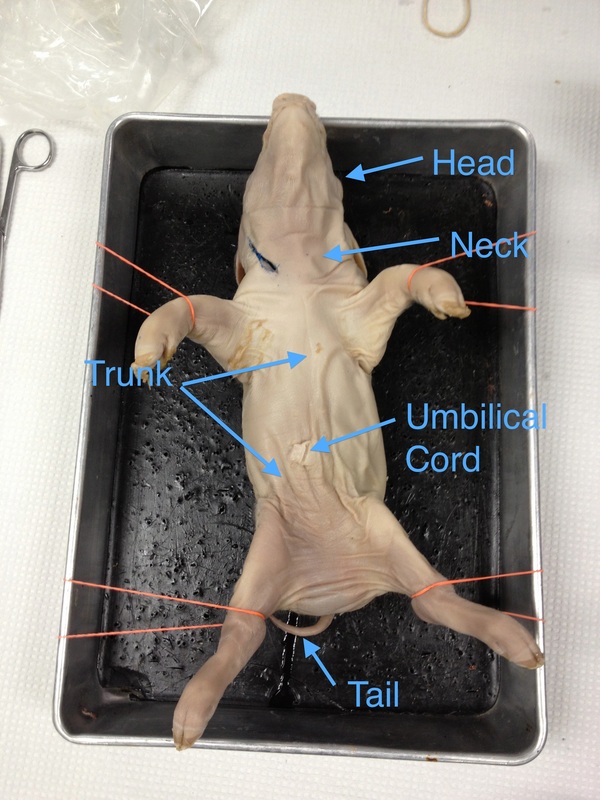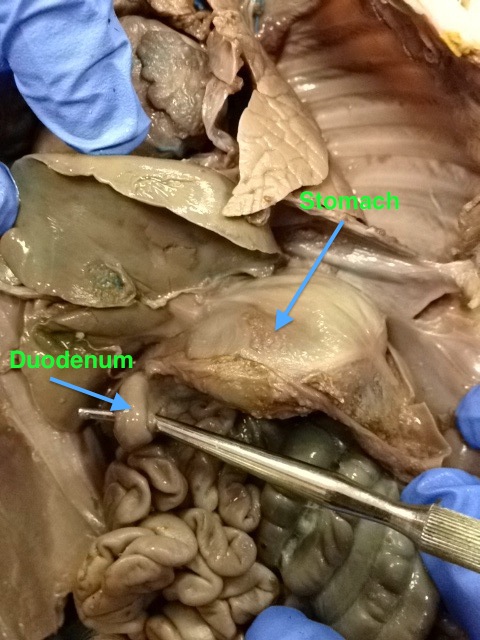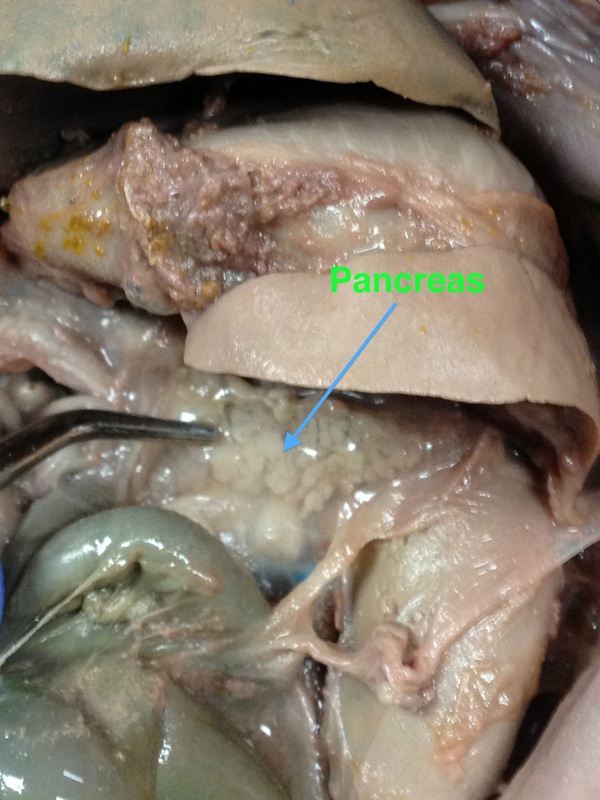External Anatomy
Figure One: Ventral exterior side of the fetal pig. Observe the head, neck, trunk, umbilical cord, and tail.
Figure two: Close up picture of the pig's tongue, snout, eyelid, and external ear/pinnae.
Figure Three: Close up of snout, nares, and tongue. Notice how the nares are the equivalent to human nostrils.
Figure Four: Picture of hoof, wrist, and elbow. Similar to human arm.
Figure Five: Picture of hoof, ankle, and knee. Similar to human leg.
Figure Six: Observe a close view of female genetailia.
Figure Seven: Picture of male testis. Notice how the pig is not fully developed, yet there is a small bulge present. The male reproductive organs will develop more, later in a pig's life.
Figure Eight: Notice the female teats and umbilical cord. The cord was cut to observe the opening where the pig receives nutrients from the mother while in the uterus.
Figure Nine: Measurement of pig on the dorsal side. Pig was 35 cm from snout to tip of tail. From this measurement we can conclude that pig was 111 days old.
Figure Ten: Close picture of iris. Notice the cloudy state due to death.
Internal Anatomy
Figure Eleven: The numbers show the order by which the pig was cut on the ventral side.
Figure Twelve: The exposed organs on the ventral side of the fetal pig. Try to identify the major organs such as the liver, large intestine, small intestine, and spleen.
The Organs of the Digestive System
Figure Thirteen: Observe the liver, large intestine, small intestine, and spleen. Notice the multiple lobes of the liver, the tube-like structure of the intestines and smooth leech-like structure of the spleen.
Organs of the Circulatory System
Figure 14: Picture of the heart, left lung and right lung (Circulatory System). Notice how the lungs surround the heart and the heart has many veins and arteries.
Organs of the Respiratory System
Figure 22: The left lung is shown. It contains two lobes, with an extensive lining look.
Figure 23: The right lung is shown and is similar to that of the left lung, with the exception of three lobes instead of two.
Figure 15: Close up picture of the neck region. The trachea has C-like structures, called the cartilaginous layers, that surround it. The thymus is adjacent to the trachea.
Figure 16: Picture of neck opened to expose the trachea and the thyroid. The thyroid has been cut during dissection, and the Cartilaginous layers are once again observable.
Figure 17: Observe the neck region once again. The trachea, larynx and esophagus are shown. Notice how the esophagus is pulled from behind the trachea. The larynx, or voice box, is proximal (above) to the trachea.
A Closer Look at Organs of the Digestive System
Figure 18: The right and left kidneys are shown, along with the rectum. Observe the covering of the right kidney. This was cut on the left to expose the kidney. Notice the puncture in the left kidney cause by the cutting of the covering (or the cause of death). The rectum is a tube-like structure that leads to the anus.
Figure 19: Observe the stomach and the duodenum in reference to intestines. The duodenum has been pulled forward from behind the intestines. The stomach inflates like a balloon when full.
Figure 20: Pictured is the gall bladder. Notice the dark shading.
Figure 21: The pancreas is shown. Notice its position in reference to the spleen. Observe how the composition is similar to that of cottage cheese.
In Loving Memory
Piglet Raraham Smith
July 28th, 2012-November 15th, 2012
Beloved wife, daughter and friend to many, Piglet is joined in death by her husband Jorge Smith. Piglet died at AH Farms early this morning. Piglet was born 111 days ago at AH Farms and lived a good life, one filled with many mud baths, slop meals, and grazing by the fence.
Piglet had an unfortunate run in with a rooster this past morning that led to the farm's nasty rooster pecking Piglet in the back. Due to the fact that the kidney is located on the dorsal side of the body, she suffered from a punctured kindey that casued her to bleed internally to death. We mourn over this cause of death and the loss of Piglet, but we know that Piglet would have wanted to be researched and dissected.
Piglet Raraham Smith
July 28th, 2012-November 15th, 2012
Beloved wife, daughter and friend to many, Piglet is joined in death by her husband Jorge Smith. Piglet died at AH Farms early this morning. Piglet was born 111 days ago at AH Farms and lived a good life, one filled with many mud baths, slop meals, and grazing by the fence.
Piglet had an unfortunate run in with a rooster this past morning that led to the farm's nasty rooster pecking Piglet in the back. Due to the fact that the kidney is located on the dorsal side of the body, she suffered from a punctured kindey that casued her to bleed internally to death. We mourn over this cause of death and the loss of Piglet, but we know that Piglet would have wanted to be researched and dissected.
Thanks observing Piglet with us. We hope you learned a lot!
























 RSS Feed
RSS Feed